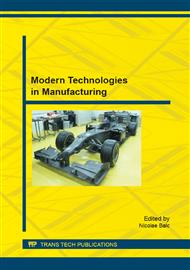p.199
p.205
p.213
p.221
p.226
p.233
p.239
p.246
p.252
Approach for Obtaining Broken Plastic Parts Using Reverse Engineering Tools
Abstract:
Reverse engineering process has been demonstrated to be reliable solution in solving problems regarding missing information and/or details referred to the functional areas of parts. Based on the specific activities of the chain of processes that defines the reverse engineering concept it can be collected essential information in order to reconstitute important zones of broken parts. The present paper describes an approach that was used to recover a plastic gear part. The case study provided a moulded injected plastic part that was broken during the normal function. The entire process supposed scanning the toothed area that remained and rebuild the contour that was used in CAM software as input data and especially the machining strategy used to perform both sides of the part. The machining process was employed on a CNC graving machine tool.
Info:
Periodical:
Pages:
226-232
Citation:
Online since:
November 2015
Authors:
Keywords:
Price:
Сopyright:
© 2015 Trans Tech Publications Ltd. All Rights Reserved
Share:
Citation:


